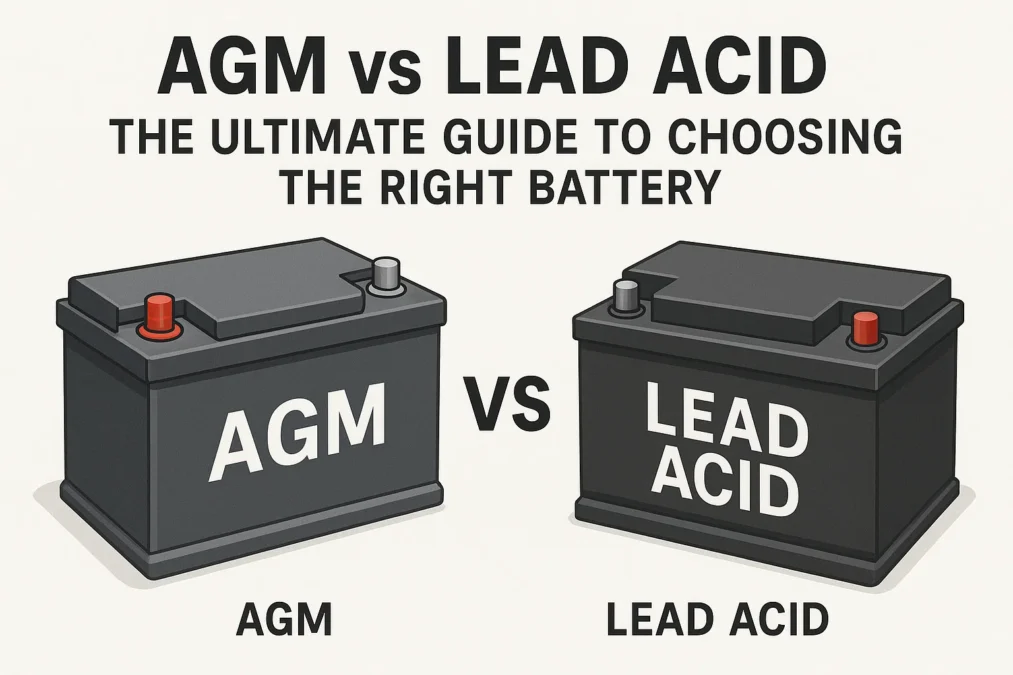You need a new battery. Maybe your car won’t start on a cold morning, or you’re upgrading the power system on your boat, or perhaps you’re finally building that off-grid solar array you’ve been dreaming about. You head online or to the auto parts store, and you’re immediately hit with a barrage of acronyms and choices: Flooded, AGM, Gel, Deep Cycle, Starting. The most common dilemma? The classic showdown: AGM vs Lead Acid.
While it might seem like a simple choice, the decision between an Absorbent Glass Mat (AGM) battery and a traditional flooded lead-acid battery is crucial. Picking the wrong one can mean wasted money, poor performance, and a battery that gives up on you far too soon. The truth is, both have their place, but one is almost certainly better for your specific needs.
This comprehensive guide is designed to cut through the confusion. We’re going to dive deep into the technology behind these power sources, compare them head-to-head on every important factor, and give you the clear, expert advice you need to make an informed decision. We’ll explore not just the “what,” but the “why,” helping you understand the science so you can shop with confidence. Let’s settle the AGM vs Lead Acid debate once and for all.
Understanding the Basics: The Heart of the Matter
Before we pit these two technologies against each other, it’s essential to understand what they are and how they fundamentally work. Both are, at their core, lead-acid batteries. They generate power through a chemical reaction between lead plates and a sulfuric acid electrolyte. Where they differ dramatically is in their construction and how they manage that all-important electrolyte, which leads to vastly different performance characteristics.
The traditional flooded lead-acid battery, often called an FLA or simply a “wet cell,” is the original design that’s been powering vehicles for over a century. Inside its sturdy plastic case, you’ll find alternating positive and negative lead plates submerged in a pool of liquid electrolyte solution. This design is simple, proven, and inexpensive to manufacture. However, this liquid sloshing around freely imposes some significant limitations, which we’ll explore in detail throughout this article.
The Evolution of Battery Technology
The quest to overcome the limitations of the flooded battery led to the development of Valve-Regulated Lead-Acid (VRLA) batteries. This is a sealed design where the electrolyte is immobilized, making the battery safer and maintenance-free. AGM vs Lead Acid is often, more accurately, AGM (a type of VRLA) vs Flooded (a type of wet cell). AGM technology, which became commercially viable in the 1980s, represents a significant evolutionary step. Instead of loose liquid, the electrolyte is suspended in a fine fibreglass mat that is sandwiched between the lead plates. This simple-sounding change is a revolutionary engineering feat that unlocks a host of advantages.
How a Traditional Flooded Lead-Acid Battery Works
Let’s start with the classic workhorse. A flooded battery is a marvel of simple electrochemistry. The positive plates are made of lead dioxide (PbO₂), and the negative plates are made of porous lead (Pb). The electrolyte is a mixture of sulfuric acid (H₂SO₄) and water. When you draw power from the battery (discharging it), a chemical reaction occurs: the acid in the electrolyte reacts with the materials on both plates, converting them to lead sulfate (PbSO₄) and releasing electrical energy. When you charge the battery, this reaction is reversed.
The “flooded” name comes from the fact that the plates are completely immersed in the liquid electrolyte. This design requires vents to allow the hydrogen and oxygen gases produced during charging to escape safely from the battery. This is why they are not sealed and must be installed upright to prevent acid spills. This venting process also leads to water loss over time, which is why they require periodic maintenance—you have to top them up with distilled water to keep the plates covered and the chemistry functioning correctly.
The Strengths and Shortcomings of the Flooded Design
The primary strength of this design is its cost-effectiveness and ability to deliver massive bursts of current, which is perfect for starting engines. However, the free liquid is also its greatest weakness. If the battery is tipped over, acid can spill, causing damage and posing a safety hazard. The venting of gases can also lead to corrosion of nearby terminals and metal parts. Furthermore, the chemical process is relatively slow, meaning they don’t charge as quickly as other types and can suffer from damage if they are discharged too deeply or too often.
How an AGM (Absorbent Glass Mat) Battery Works
An AGM battery is a smarter, more refined version of the lead-acid concept. It retains the same fundamental chemistry—lead plates and sulfuric acid—but it completely reengineers how the electrolyte is stored. Between each lead plate, there is a ultra-thin mat woven from microscopic borosilicate glass fibers. This mat is not just a spacer; it’s the key to the battery’s performance.
These glass mats are highly porous and absorbent, holding the electrolyte in place like a sponge. This immobilization is nearly 100% effective, meaning there is no free liquid inside the battery. The mats are saturated with just enough electrolyte to facilitate the chemical reaction, but not so much that it can slosh around. This design also creates a unique internal environment. The tiny pockets of oxygen gas produced during charging can move easily through the empty pores in the mat to recombine with hydrogen at the negative plate, reforming into water. This recombinant process minimizes water loss and gas venting, making the AGM battery truly sealed and maintenance-free.
The Engineering Marvel of the Glass Mat
The glass mat does more than just hold acid. It tightly compresses the plates, which dramatically reduces the distance ions must travel between plates. This lower internal resistance is the secret behind the AGM’s superior performance. It allows for faster charging, higher power output, and better efficiency compared to a flooded battery of the same size. Furthermore, the compressed plates and immobilized electrolyte make the AGM battery incredibly robust and resistant to vibration, a major cause of failure in traditional batteries.
Head-to-Head Comparison: Key Factors to Consider
Now that we understand how they’re built, let’s put them head-to-head across the most important criteria you should consider when making your choice. This is where the AGM vs Lead Acid debate gets practical.
Cost and Value: Upfront Price vs. Long-Term Investment
This is often the first and most decisive factor for many buyers. There is no getting around it: a traditional flooded battery is the clear winner on upfront cost. You can typically purchase a quality flooded battery for about half the price of a comparable AGM battery. This low entry point is why they remain the standard OEM (Original Equipment Manufacturer) choice for most new cars and budget-conscious replacements.
However, value is about more than just the initial purchase price. This is where the AGM vs Lead Acid discussion gets interesting. While an AGM battery costs more upfront, it almost always offers a longer service life. It’s not uncommon for a well-maintained AGM battery to last 2-3 times longer than a flooded battery in the same application. When you factor in its longer lifespan, superior performance, and zero maintenance costs, the total cost of ownership of an AGM battery can often be lower. It’s a classic case of “pay now, or pay later.”
Performance and Power Delivery
When it comes to raw power, both types can be impressive, but they excel in different ways. Flooded batteries are renowned for their ability to deliver a very high cold cranking amps (CCA) rating—a measure of the burst of power needed to start an engine in cold weather—for a very low cost. This makes them excellent dedicated starting batteries.
AGM batteries, however, are performance powerhouses. Thanks to their lower internal resistance, they can deliver even higher power outputs more efficiently. They often have higher CCA ratings per battery size and provide a more stable voltage under load. This means stronger, more reliable starts and better performance for high-demand electrical systems. They also have a much higher reserve capacity (RC), meaning they can power accessories for a longer period if the engine is off. This superior discharge and charge performance is a key advantage in the AGM vs Lead Acid battle.
Lifespan and Durability: Which Battery Goes the Distance?
Lifespan is where the AGM battery truly begins to justify its higher price tag. A typical flooded car battery might last 3-5 years under good conditions. An AGM battery in the same vehicle can easily last 5-7 years, and often longer, especially if it’s kept in a state of high charge.
The reasons for this longevity are rooted in its construction. The AGM design is incredibly resistant to vibration, which is a primary killer of traditional batteries—the shaking can cause active material to shed from the plates or internal connections to fail. The recombinant cycle in AGM batteries also means virtually no water loss and less degradation of the plates over time. Furthermore, AGM batteries are much better at handling deep discharges. While repeatedly draining any lead-acid battery will kill it, an AGM can be discharged to 80% depth of discharge (DOD) hundreds of times, whereas a flooded battery might only tolerate 50% DOD a dozen times before failing.
Maintenance Requirements: Set-and-Forget vs. Hands-On Care
This is a black-and-white difference. An AGM battery is completely maintenance-free. It is sealed for life. You install it, connect it, and you never have to think about it again until it’s time for a replacement. There are no caps to open and no water levels to check.
A flooded battery, by its very nature, requires regular maintenance to achieve its maximum lifespan. The electrolysis and evaporation that occur during normal charging cause the battery to lose water over time. If the water level falls below the top of the plates, it exposes them to air, causing rapid sulfation (a process that reduces capacity and kills the battery) and extreme heat damage during charging. To prevent this, you must periodically open the vents, check the electrolyte levels, and top them up with distilled water. For many users, this is a messy, inconvenient, and often forgotten chore.
Safety and Installation Flexibility
Safety is a major point of consideration. A flooded battery contains liquid sulfuric acid that can leak or spill if the case is cracked or the battery is tipped over. This acid is highly corrosive and dangerous. They also vent explosive hydrogen gas, especially during charging, which requires them to be installed in a well-ventilated area to prevent the buildup of dangerous gas pockets.
AGM batteries are vastly safer and more flexible. Because the electrolyte is fully absorbed and the battery is sealed, there is zero risk of acid leakage, even if the case is breached (unless it is completely crushed). They are considered non-spillable and can be shipped without hazardous materials restrictions. The recombinant process means they vent negligible amounts of gas, making them safe for installation in confined, unventilated, or indoor spaces like a car trunk, cabin, or an RV’s living area. They can also be mounted on their side or in other orientations, providing incredible flexibility for tight or unusual engine bays.
Charging Requirements and Compatibility
This is a critical and often misunderstood aspect of the AGM vs Lead Acid comparison. Can you charge an AGM battery with a regular charger? The short answer is yes, but not optimally. While they use the same fundamental chemistry, their optimal charging voltages are different.
A standard flooded battery charger typically has a higher absorption voltage (around 14.4-14.8 volts) and a float voltage around 13.2-13.4 volts. An AGM battery requires a slightly lower absorption voltage (typically 14.4-14.6 volts) and a lower float voltage (around 13.2-13.4 volts is usually safe). Using an old, unregulated charger designed for flooded batteries can overcharge an AGM battery, causing excessive heat and shortening its life.
Most modern smart chargers and vehicle alternators have a specific “AGM” setting that applies the correct charging algorithm. Many newer cars with start-stop technology, which almost always use AGM batteries, have complex battery management systems (BMS) that handle this automatically. The key takeaway is that while an AGM is forgiving, to get the longest life from it, you should use a charger with a dedicated AGM mode.
PS4 vs Xbox One Which Gaming Console Reigns Supreme?
Environmental Impact and Resistance
Both battery types are nearly 100% recyclable, which is a huge environmental positive. The lead-acid battery boasts the highest recycling rate of any consumer product in the world. However, the AGM design has some subtle environmental advantages.
First, its longer lifespan means fewer batteries need to be manufactured and recycled over the long term. Second, because there is no risk of acid spillage, there is no danger of contaminating soil or groundwater during use, storage, or transportation. Their superior resistance to vibration also means they are less likely to fail prematurely due to physical shock, again contributing to a longer service life and less waste.
In terms of operational environment, AGM batteries are far more resilient. They have a much lower self-discharge rate, meaning they can sit on a shelf or in a vehicle for months and still hold a usable charge. They also perform significantly better in cold weather, delivering more reliable starting power and being less susceptible to freezing (though a fully charged battery of either type is resistant to freezing).
Choosing the Right Battery for Your Application
So, with all this information, which battery is right for you? The choice ultimately depends on how and where you plan to use it.
When to Choose a Traditional Flooded Lead-Acid Battery
The flooded battery is the economical and practical choice for several scenarios. It is ideal for standard gasoline-powered vehicles used for normal daily driving, where cost is the primary concern and the electrical demands are minimal—just starting the engine and running basic accessories like lights and radio. They are perfect for budget-conscious consumers, older vehicles that originally came with flooded batteries, and applications where maintenance isn’t an issue, such as in a garage-kept classic car.
They are also well-suited for certain deep-cycle applications where the absolute lowest upfront cost is necessary, such as in a solar power system for a shed with a very tight budget, provided you are diligent about maintenance and careful not to over-discharge them.
When an AGM Battery is the Superior Choice
The investment in an AGM battery is easily justified in a wide range of demanding applications. They are the undisputed champion for vehicles with high electrical loads. This includes modern cars with advanced start-stop systems, which require a battery that can handle hundreds of deep discharge cycles per week. They are essential for RVs, boats, and campers where powering inverters, refrigerators, and other appliances is common, and where their safety and installation flexibility are major benefits.
AGM is the go-to choice for performance and luxury vehicles where reliable, high-power delivery is critical for complex electronics and powerful stereo systems. They are excellent for off-road vehicles and motorcycles due to their extreme vibration resistance. For solar and wind power systems, their ability to charge efficiently, handle deeper discharges, and require no maintenance makes them a fantastic choice, albeit at a higher initial cost than flooded. If your priority is a true “install and forget” solution with maximum reliability and longevity, the AGM is the clear winner in the AGM vs Lead Acid decision.
A Quick Word on Gel Batteries: Another VRLA Option
It’s worth briefly mentioning Gel batteries, as they are often grouped with AGM as a “sealed” alternative. Gel batteries also immobilize the electrolyte, but they do so by turning it into a jelly-like substance using silica additive. While they share the maintenance-free and spill-proof benefits of AGM, they have some distinct differences.
Gel batteries are even more sensitive to overcharging and require very specific charging voltages. They typically cannot handle high charge or discharge currents as well as AGM batteries. This makes them less ideal for high-power applications like engine starting but excellent for very deep, slow discharge cycles, such as in wheelchairs or trolling motors. For most automotive and high-power applications, AGM is generally preferred over Gel due to its robustness and power capabilities.
Making the Switch: Can You Replace a Flooded Battery with an AGM?
In the vast majority of cases, yes, you can directly replace a flooded lead-acid battery with an AGM battery, and you will likely see an improvement in performance and reliability. However, there is one crucial caveat: the charging system.
As discussed, AGM batteries require a slightly different charging voltage. If your vehicle is older (typically pre-2010) and was originally equipped with a flooded battery, its alternator and voltage regulator are programmed to charge at voltages that are safe for flooded batteries but may be slightly high for an AGM. Over many years, this could lead to overcharging and reduced AGM battery life.
For modern vehicles with smart charging systems, this is rarely an issue. If you are unsure, the best practice is to have a mechanic check your vehicle’s charging voltage. If it consistently runs above 14.8 volts, it might be too high for an AGM. In most cases, though, the difference is small enough that the AGM will still perform well and last a long time, making the upgrade worthwhile.
Conclusion
The AGM vs Lead Acid debate doesn’t have a single winner; it has a right tool for the right job. The traditional flooded lead-acid battery remains a reliable, cost-effective solution for simple, budget-focused applications where maintenance is not a concern. It’s the tried-and-true workhorse that has served us well for generations.
However, AGM battery technology represents a significant leap forward. Its superior performance, exceptional durability, complete freedom from maintenance, and enhanced safety make it a compelling upgrade for virtually any application. While the initial price is higher, the long-term value, reliability, and peace of mind it offers often make it the smarter investment.
When you’re making your decision, look beyond the price tag. Consider how you use your vehicle or equipment, the electrical demands you place on it, and the value of your own time and convenience. For anyone with modern electrical needs, a demanding environment, or a simple desire for the best possible performance, the choice in the AGM vs Lead Acid discussion becomes clear: AGM is the modern, superior power solution.
Frequently Asked Questions (FAQ)
What is the main difference between an AGM and a standard lead-acid battery?
The main difference lies in the electrolyte design. A standard flooded lead-acid battery has liquid electrolyte sloshing freely around the lead plates. An AGM (Absorbent Glass Mat) battery suspends its electrolyte in a fine fibreglass mat, making it spill-proof, maintenance-free, and capable of higher performance due to lower internal resistance. This fundamental design change is what drives all the other differences in lifespan, power, and safety.
Is an AGM battery worth the extra cost?
For most people, yes. While the upfront cost is higher, an AGM battery typically lasts significantly longer (often 2-3 times longer) than a comparable flooded battery. When you factor in its longer lifespan, zero maintenance requirements, better performance, and improved reliability, the total cost of ownership often makes it a better value in the long run. It’s an investment in convenience and peace of mind.
Can I use a normal battery charger on an AGM battery?
You can, but you shouldn’t use an old, unregulated “dumb” charger. While an AGM battery will charge with a standard flooded battery charger, it may not charge optimally and could be subjected to voltages that are too high, potentially reducing its lifespan. For the best results and to maximize your investment, you should use a modern “smart” charger that has a dedicated charging mode or setting for AGM batteries.
Why are AGM batteries better for start-stop systems?
Start-stop systems place enormous strain on a battery. They require it to discharge deeply hundreds of times per week to power the vehicle’s electronics when the engine is off and then recharge quickly when the engine restarts. Flooded batteries are not designed for this kind of deep cycling and would fail quickly. AGM batteries are specifically engineered to handle repeated deep discharges and rapid recharges, making them the only suitable choice for this technology.
Do AGM batteries require any special maintenance?
No, that’s one of their biggest advantages. AGM batteries are completely sealed and maintenance-free. There are no caps to open and no electrolyte levels to check. You never have to add water. Your only responsibility is to keep the terminals clean and ensure the battery is kept in a good state of charge, preferably with a battery maintainer if the vehicle is stored for long periods.
Comparison Table: AGM vs. Flooded Lead-Acid Batteries
| Feature | AGM Battery | Flooded Lead-Acid Battery |
|---|---|---|
| Upfront Cost | Higher (approx. 2x the cost) | Lower (Budget-friendly) |
| Lifespan | Longer (5-7+ years) | Shorter (3-5 years) |
| Maintenance | None (Maintenance-Free) | Required (Water topping) |
| Power Output | Higher (More CCA per size) | High (Good for starting) |
| Deep Cycle Ability | Good (Tolerates deep discharges) | Poor (Damaged by deep cycles) |
| Vibration Resistance | Excellent | Poor |
| Spill/Safety Risk | None (Sealed & Spill-proof) | Yes (Liquid acid can leak) |
| Installation Orientation | Any (Even on side) | Upright only |
| Charging Requirements | Prefers smart charger/AGM mode | Compatible with most chargers |
| Self-Discharge Rate | Very Slow (1-3% per month) | Faster (5%+ per month) |
| Best For | Start-stop cars, RVs, boats, high-end audio, solar | Standard cars, budget replacements, simple uses |
Quotes
“The debate isn’t about which battery is ‘better’ in a vacuum, but which is better for your specific needs and budget. AGM represents the modern evolution of lead-acid technology, offering performance and convenience that flooded batteries simply cannot match.” — Anonymous Automotive Engineer
“Choosing a flooded battery is often a decision based solely on initial price. Choosing an AGM is an investment calculated on long-term value, reliability, and the luxury of never having to check the water level again.” — Marine Electrical Systems Specialist



